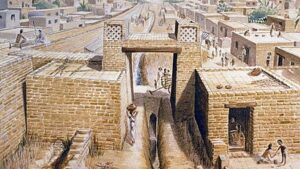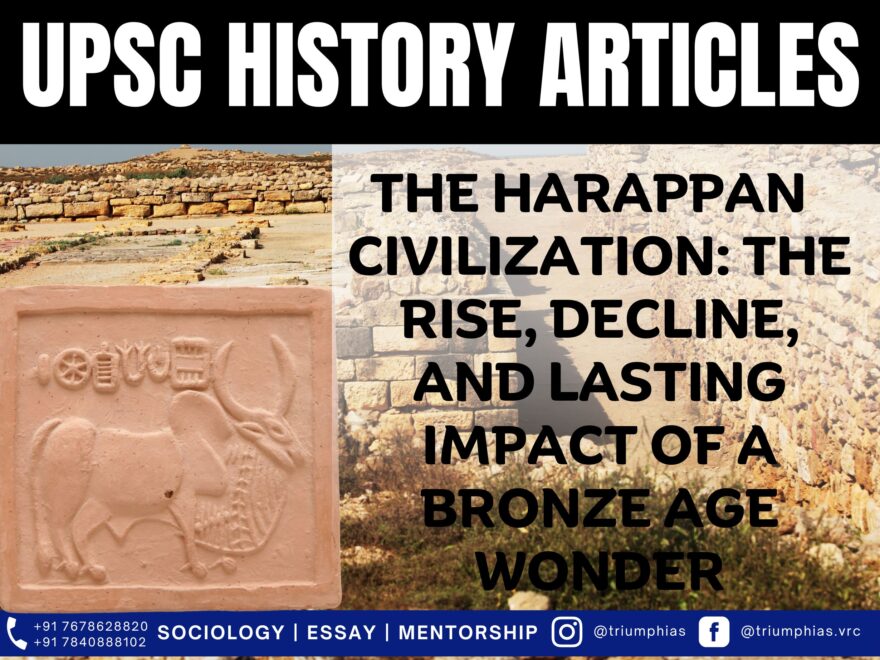Harappan Civilization
(Relevant for Historical Section of General Studies Paper Prelims/Mains)

Indus Valley Civilization
The Harappan Civilization, often referred to as the Harappan Civilization, was a prominent Bronze Age society that thrived in the north western areas of South Asia. Its zenith occurred from 2600 BCE to 1900 BCE, with its broader existence spanning from 3300 BCE to 1300 BCE. This remarkable civilization was one of the three notable ancient civilizations, alongside Egypt and Mesopotamia. The narrative of the Harappan Civilization’s ascent and decline can be ascribed to a multitude of factors that influenced its developmental trajectory.
The civilization emerged and flourished due to several key elements:
- Geographic Advantages: The presence of fertile land and abundant water resources within the basins of the Indus River and its tributaries played a pivotal role in supporting agriculture and irrigation. This, in turn, led to an excess of food production, driving population expansion and the emergence of urban centers.
- Trade and Cultural Interactions: The Harappan Civilization actively participated in extensive trade networks with neighboring regions and even distant lands, including Mesopotamia, Central Asia, and the Persian Gulf. This facilitated not only cultural exchange but also economic prosperity and the acquisition of valuable resources.
- Urban Development and Infrastructure: This civilization showcased advanced urban planning and architectural techniques. Their cities were distinguished by well-structured layouts, construction of baked brick houses, sophisticated drainage systems, water distribution networks, public bathing facilities, granaries, and spacious non-residential structures. Such efficient infrastructure reflected a highly organized society.
- Technological Progress: The Harappan Civilization displayed exceptional skill and innovation in various crafts and technologies. Their production of items like pottery, seals, beads, jewelry, terracotta figurines, bronze tools and weaponry, as well as standardized systems of weights and measures, not only underscored their technical prowess but also significantly contributed to their economic growth.
- Environmental Transformations: The region underwent notable environmental shifts, encompassing alterations in climate patterns, reduced monsoon rainfall, shifts in river courses, and heightened occurrences of both floods and droughts. These environmental transformations exerted profound effects on agriculture, water resources, and the overall stability of the civilization.
- Invasions and Migrations: The arrival of external groups, potentially the Indo-Aryans from Central Asia, introduced new cultural elements and languages to the region. These waves of migration and potential invasions disrupted the social cohesion and political equilibrium of the civilization.
- Diminished Trade and Resources: The waning of trade and commercial exchanges with neighbouring regions resulted in diminished economic resources and influence for the Indus population. The degradation of urban infrastructure and public services also had adverse repercussions on the inhabitants’ quality of life and well-being.
- Despite its decline, the Harappan Civilization has bequeathed remarkable contributions to human history:
- Urban Planning and Engineering: The civilization’s intricate urban planning and engineering systems, encompassing drainage, water management, and sanitation, set exemplary standards for public welfare and significantly influenced subsequent civilizations.
- Material Culture and Artistry: The diverse and opulent material culture of the Indus people, spanning pottery, seals, jewelry, and bronze tools, showcased their artistic ingenuity and technological prowess.
- Complex Society and Potential Literacy: The existence of a complex societal structure with indications of a possible writing system underscored the importance of communication, record-keeping, and the expression of religious beliefs and artistic creativity.
- A Peaceful Civilization: The absence of conspicuous indications of violence or warfare in the archaeological record implies the presence of a peaceful and harmonious civilization that maintained social order and cultural cohesion.
The Indus Harappan Civilization flourished due to geography, trade, urban planning, and technology. It declined due to environmental changes, invasions, and economic challenges. Its contributions include early urbanization, advanced engineering, rich material culture, indications of a complex society, and a peaceful civilization.
Sample Question for UPSC Sociology Optional Paper:
Question 1: What geographic advantages contributed to the rise of the Harappan Civilization?
Answer:
The fertile land and abundant water resources within the basins of the Indus River and its tributaries were pivotal in supporting agriculture and irrigation, which in turn led to population growth and urbanization.
Question 2: How did trade and cultural interactions influence the Harappan Civilization?
Answer:
The harappan civilization actively engaged in trade networks with regions like Mesopotamia, Central Asia, and the Persian Gulf, facilitating economic prosperity, resource acquisition, and cultural exchange.
Question 3: Describe the urban planning and infrastructure of the Harappan Civilization.
Answer:
The harappan civilization featured well-planned cities with baked brick houses, sophisticated drainage systems, water distribution networks, public bathing facilities, and granaries, reflecting a highly organized society.
Question 4: What factors led to the decline of the harappan Civilization?
Answer:
Environmental changes, external invasions and migrations, and diminished trade and resources contributed to its decline.
Question 5: What lasting contributions did the harappan Civilization make to human history?
Answer:
The harappan civilization set standards in urban planning and engineering, had a rich material culture, showed signs of a complex societal structure, and maintained a generally peaceful and harmonious social order.
To master these intricacies and fare well in the Sociology Optional Syllabus, aspiring sociologists might benefit from guidance by the Best Sociology Optional Teacher and participation in the Best Sociology Optional Coaching. These avenues provide comprehensive assistance, ensuring a solid understanding of sociology’s diverse methodologies and techniques.
Harappan Civilization, Bronze Age, South Asia, Urban Planning, Trade Networks, Technological Advancements, Environmental Changes, Indo-Aryans, Decline and Contributions, Indus Valley Civilization, Harappan Civilization, Bronze Age, South Asia, Indus Valley Civilization, Harappan Civilization, Harappan Civilization
Choose The Best Sociology Optional Teacher for IAS Preparation?
At the beginning of the journey for Civil Services Examination preparation, many students face a pivotal decision – selecting their optional subject. Questions such as “which optional subject is the best?” and “which optional subject is the most scoring?” frequently come to mind. Choosing the right optional subject, like choosing the best sociology optional teacher, is a subjective yet vital step that requires a thoughtful decision based on facts. A misstep in this crucial decision can indeed prove disastrous.
Ever since the exam pattern was revamped in 2013, the UPSC has eliminated the need for a second optional subject. Now, candidates have to choose only one optional subject for the UPSC Mains, which has two papers of 250 marks each. One of the compelling choices for many has been the sociology optional. However, it’s strongly advised to decide on your optional subject for mains well ahead of time to get sufficient time to complete the syllabus. After all, most students score similarly in General Studies Papers; it’s the score in the optional subject & essay that contributes significantly to the final selection.
“A sound strategy does not rely solely on the popular
Opinion of toppers or famous YouTubers cum teachers.”
It requires understanding one’s ability, interest, and the relevance of the subject, not just for the exam but also for life in general. Hence, when selecting the best sociology teacher, one must consider the usefulness of sociology optional coaching in General Studies, Essay, and Personality Test.
The choice of the optional subject should be based on objective criteria, such as the nature, scope, and size of the syllabus, uniformity and stability in the question pattern, relevance of the syllabic content in daily life in society, and the availability of study material and guidance. For example, choosing the best sociology optional coaching can ensure access to top-quality study materials and experienced teachers. Always remember, the approach of the UPSC optional subject differs from your academic studies of subjects. Therefore, before settling for sociology optional, you need to analyze the syllabus, previous years’ pattern, subject requirements (be it ideal, visionary, numerical, conceptual theoretical), and your comfort level with the subject.
This decision marks a critical point in your UPSC – CSE journey, potentially determining your success in a career in IAS/Civil Services. Therefore, it’s crucial to choose wisely, whether it’s the optional subject or the best sociology optional teacher. Always base your decision on accurate facts, and never let your emotional biases guide your choices. After all, the search for the best sociology optional coaching is about finding the perfect fit for your unique academic needs and aspirations.
To master these intricacies and fare well in the Sociology Optional Syllabus, aspiring sociologists might benefit from guidance by the Best Sociology Optional Teacher and participation in the Best Sociology Optional Coaching. These avenues provide comprehensive assistance, ensuring a solid understanding of sociology’s diverse methodologies and techniques. Sociology, Social theory, Best Sociology Optional Teacher, Best Sociology Optional Coaching, Sociology Optional Syllabus.
Best Sociology Optional Teacher, Sociology Syllabus, Sociology Optional, Sociology Optional Coaching, Best Sociology Optional Coaching, Best Sociology Teacher, Sociology Course, Sociology Teacher, Sociology Foundation, Sociology Foundation Course, Sociology Optional UPSC, Sociology for IAS,
Follow us :
🔎 https://www.instagram.com/triumphias
🔎https://www.youtube.com/c/TriumphIAS
https://t.me/VikashRanjanSociology
Find More Blogs
|
Scope of the subject and comparison with other social sciences |
|||
|
|
|
|
Modernity and social changes in Europe |


Good morning,
I am K Parameshwari
This information very useful to me.so,Thank you for giving informations